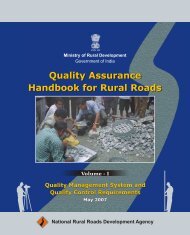Grameen Sampark Final April 0... - pmgsy
Grameen Sampark Final April 0... - pmgsy
Grameen Sampark Final April 0... - pmgsy
Create successful ePaper yourself
Turn your PDF publications into a flip-book with our unique Google optimized e-Paper software.
8<br />
materials used for production of blocks; physical<br />
requirement, test methods, sampling and acceptance<br />
criteria etc., have already been presented in BIS Code<br />
[8].<br />
Bedding Sand and Joint Filling Sand<br />
It is a well established fact that if proper attention is not<br />
paid to the quality of bedding sand, and if the thickness<br />
of bedding sand layer is not kept uniform, serious<br />
irregularities in surface profile can occur result and<br />
consequently excessive differential deformations and<br />
rutting can early in the service life of block pavement.<br />
The gaps in between the two adjacent paving blocks<br />
(typically about 3 mm wide) need to be filled in with<br />
sand which should relatively be finer than the bedding<br />
sand. The gradations of bedding sand and joint filling<br />
sand are given in Table 1.<br />
It is necessary to restrict the fines (silt and/ or clay,<br />
passing 75 micron sieve) to about 10 percent, since<br />
excessive fines make joint filling very difficult. Similarly,<br />
it is not advisable to use cement in the joint filling sand,<br />
which would not only make difficult to completely fill<br />
the joints, but may also adversely affect the desired<br />
flexibility characteristics of the paving block layer. The<br />
joint filling sand should preferably be as dry as possible;<br />
otherwise complete filling of joints will be difficult [7].<br />
Table 1: Gradations of Bedding Sand and<br />
Joint Filling Sand<br />
IS Sieve Size Bedding Sand Joint Filling Sand<br />
Percent Passing by Weight<br />
9.52 mm 100 -<br />
4.75 mm 95-100 -<br />
2.36 mm 80-100 100<br />
1.18 mm 50-95 90-100<br />
600 micron 25-60 60-90<br />
300 micron 10-30 30-60<br />
150 micron 0-15 15-30<br />
75 micron 0-10 0-10<br />
<strong>Grameen</strong> <strong>Sampark</strong><br />
Base and Sub Base Materials<br />
The main purpose of providing base materials are the<br />
load spreading properties to disperse stresses to the<br />
subgrade level and to provide the desired drainage<br />
characteristics, which would have significant bearing<br />
on performance of a block pavement. Although, local<br />
availability and economics generally dictate the choice<br />
of base materials at the design stage, yet the commonly<br />
used materials considered suitable for base courses are<br />
unbound crushed rock, water-bound macadam, wet<br />
mix macadam, cement bound crushed rock/ granular<br />
materials, and lean cement concrete/ dry lean concrete<br />
etc. In broad terms, wherever the subgrade is weak (CBR<br />
value below 5), the use of bound granular materials,<br />
like, cement treated crushed rock, should be preferred

















